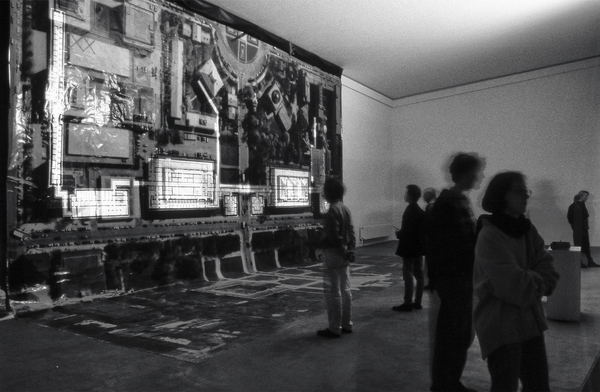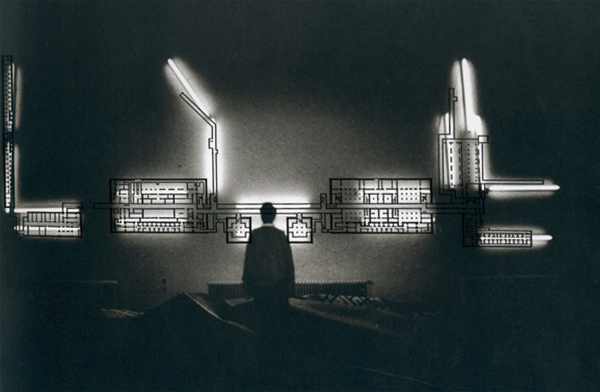Photographic Installation
Photographic Installation
Still today, German post-war collective memory is continually evolving. Its contested complexity has earned the word 'Vergangenheitsbewältigung' (coming to terms with or mastering its past) a unique place in the German language and national consciousness. The city, as a built environment, is an active participant in memory production – especially due to it being in a constant flux. The handling of, and interaction with this built environment, is shaped by its society’s collective memories and simultaneously helps shape them in return.
Stadt im Verborgenen (Hidden City) (1994) embodies Julian Rosefeldt’s earliest work complex. Developed together with his former artist-partner, Piero Steinle, for their master’s in architecture, the project directly addresses the charged history of Königsplatz in Munich. In the 1930s, the neo-classical Königsplatz underwent a fundamental shift with the rise of the National Socialist party (NSDAP): Munich came to embody the 'Hauptstadt der Bewegung' (capital city of the movement) with the party’s headquarters residing at Königsplatz itself. Until Rosefeldt and Steinle erected an on-site information board in 1995, in the context of the exhibition Bürokratie und Kult (Bureaucracy and Cult) held by the Zentralinstitut für Kunstgeschichte, any knowledge on the function and history of the NSDAP buildings had been withheld from Munich’s citizens and visitors. Whilst offsetting the flawlessly-famed portrayal of their hometown, the artists drive to expose the wound of the past and keep the bureaucratic machinery of the National Socialist perpetrators alive in present and public consciousness. A fundamental theme of the entire project: the fusing fluctuation between past and present draws our attention to the shifting status of the site over time. In addition, Stadt im Verborgenen (Hidden City) underpins many of Rosefeldt’s works in his confrontation of the still problematic dealing with German identity.
As far back as 1931, Adolf Hitler and the architect Paul Ludwig Troost began planning new buildings for the NSDAP headquarters. These were to be located in the immediate vicinity of the 'Brown House' (the party’s founding building) at the edge of Munich’s Königsplatz: a square characterised by neo-classical museum buildings and a style favoured by Hitler due to its grandeur associations and idealisation of antiquity. In addition to the two main buildings – the 'Führerbau' and the NSDAP administrative building – Hitler and Troost designed two 'Ehrentempel' (temples of honour) to house the iron sarcophagi containing the bodies of the 'Martyrs of the Movement' – Hitler’s associates in the abortive 1923 putsch. Underneath the two large party buildings, a hidden network of bunkers and connecting tunnels was constructed, the majority of which have remained structurally unchanged to this day and are now used as storage space by the new tenants. The Nazi party buildings and the 'Ehrentempel' survived the war more or less unscathed, however the latter were demolished by the Allies in 1947. The foundations of the 'Ehrentempel' survived the demolition but were densely planted shortly after the end of the war and later declared a biotope. When Rosefeldt and Steinle began their research, the former 'Führerbau' housed the University of Music and Performing Arts and the previous NSDAP administrative building was home to the Haus der Kulturinstitute (House of the Cultural Institutes) and the Zentralinstitut für Kunstgeschichte (Central Institute for Art History).
The photographic installation, Stadt im Verborgenen (Hidden City) (1994), was the artists’ first exhibition and only shown once at Munich’s Orangery. Dominating the main wall and extending onto the floor, is a front and back-lit 10 x 10 m aerial image of Königsplatz, underlaid by an architectural drawing of all existing underground bunkers and tunnels constructed by the Nazis. The layers inexorably invite visitors to consider both simultaneously. A vertically projected strip of light gradually moves across the plan, indicating to the viewer their position. In conjunction with the light strip’s placement on the map, slide projectors cast onto two facing walls photographs taken beforehand by Rosefeldt and Steinle from the exact spot, thus revealing what could be found at each respective location. At times, the light strip pauses, and photographs of details are projected onto an additional wall, next to the 10 x 10 m image. The employment of geographical context, as provided by the overlaid aerial view, upholds the artists’ push for familiarisation and acknowledgement, as the installation endeavours to uncover the constructed history, over which – literally – “grass has grown”. What unfolds is a multidimensional display of haunting consequences: a seemingly factual presentation loaded with history, it forces the once-invisible wound open. A mild case of cognitive dissonance prevails; the familiar collides with the unfamiliar in an act of reconfiguring revelation, transforming with it the location’s identity and associations.
E. Lapper, a.o.


